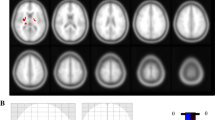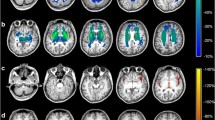Abstract
Chorea-acanthocytosis (ChAc) is a rare autosomal recessive neurodegenerative disease with erythrocyte membrane dysfunction, progressive hyperkinesia, and neuropsychological abnormalities. Neuropathologic and neuroimaging investigations demonstrate damage to the basal ganglia. Here, a novel automated technique of voxel-based magnetic resonance imaging (MRI) analysis was applied to determine the volumes of caudate nucleus and putamen in nine patients with proven ChAc in comparison with 257 healthy controls. At individual subject level, ChAc patients and controls could be reliably discriminated by the volume of the caudate, using a cut-off of 5 ml, or by a value of −3 in terms of z scores. Putaminal volumes were also significantly reduced in ChAc patients, but showed some overlap with controls. The results indicate that this new automated volumetric MRI analysis offers an objective imaging tool for identification of ChAc patients by quantification of basal ganglia atrophy and lends itself to extension to other basal ganglia diseases.





Similar content being viewed by others
References
Ahsan RL, Allom R, Gousias IS et al (2007) Volumes, spatial extents and a probabilistic atlas of the human basal ganglia and thalamus. Neuroimage 38:261–270
Al Asmi A, Jansen AC, Badhwar A et al (2005) Familial temporal lobe epilepsy as a presenting feature of choreoacanthocytosis. Epilepsia 46:1256–1263
Alonso ME, Teixeira F, Jimenez G et al (1989) Chorea-acanthocytosis: report of a family and neuropathological study of two cases. Can J Neurol Sci 16:426–431
Ashburner J, Friston KJ (2005) Unified segmentation. Neuroimage 26:839–851
Ashburner J, Flandin G, Henson R, Kiebel S, Kilner J, Mattout J, Penny W, Stephan K (2007) SPM5 Manual. http://www.fil.ion.ucl.ac.uk/spm/
Danek A, Sheesley L, Tierney M (2004) Cognitive and neuropsychiatric findings in McLeod syndrome and in chorea-acanthocytosis. In: Danek A (ed) Neuroacanthocytosis syndromes. Springer, Dordrecht
Dobson-Stone C, Danek A, Rampoldi L et al (2002) Mutational spectrum of the CHAC gene in patients with chorea-acanthocytosis. Eur J Hum Genet 10:773–781
Dobson-Stone C, Velayos-Baeza A, Filippone LA et al (2004) Chorein detection for the diagnosis of chorea-acanthocytosis. Ann Neurol 56(2):299–302
Dobson-Stone C, Velayos-Baeza A, Jansen A et al (2005) Identification of a VPS13A founder mutation in French Canadian families with chorea-acanthocytosis. Neurogenetics 6:151–158
Dubinsky RM, Hallett M, Levey R et al (1989) Regional brain glucose metabolism in neuroacanthocytosis. Neurology 39:1253–1255
Gambardella A, Muglia M, Labate A et al (2001) Juvenile Huntington’s disease presenting as progressive myoclonic epilepsy. Neurology 57:708–711
Gradstein L, Danek A, Grafman J et al (2005) Eye movements in chorea-acanthocytosis. Invest Ophthalmol Vis Sci 46:1979–1987
Hammers A, Allom R, Koepp MJ et al (2003) Three-dimensional maximum probability atlas of the human brain, with particular reference to the temporal lobe. Hum Brain Mapp 19:224–247
Hardie RJ, Pullon HW, Harding AE et al (1991) Neuroacanthocytosis. A clinical, haematological and pathological study of 19 cases. Brain 114(Pt 1A):13–49
Henkel K, Danek A, Grafman J et al (2006) Head of the caudate nucleus is most vulnerable in chorea-acanthocytosis: a voxel-based morphometry study. Mov Disord 21:1728–1731
Hosokawa S, Ichiya Y, Kuwabara Y et al (1987) Positron emission tomography in cases of chorea with different underlying diseases. J Neurol Neurosurg Psychiatry 50:1284–1287
Iwata M, Fuse S, Sakuta M et al (1984) Neuropathological study of chorea-acanthocytosis. Jpn J Med 23:118–122
Kawasaki Y, Suzuki M, Kherif F et al (2007) Multivariate voxel-based morphometry successfully differentiates schizophrenia patients from healthy controls. Neuroimage 34:235–242
Kutcher JS, Kahn MJ, Andersson HC et al (1999) Neuroacanthocytosis masquerading as Huntington’s disease: CT/MRI findings. J Neuroimaging 9:187–189
Levitt JJ, McCarley RW, Dickey CC et al (2002) MRI study of caudate nucleus volume and its cognitive correlates in neuroleptic-naive patients with schizotypal personality disorder. Am J Psychiatry 159:1190–1197
Müller-Vahl KR, Berding G, Emrich HM et al (2007) Chorea-acanthocytosis in monozygotic twins: clinical findings and neuropathological changes as detected by diffusion tensor imaging, FDG-PET and (123)I-beta-CIT-SPECT. J Neurol 254:1081–1088
Okamoto K, Ito J, Furusawa T et al (1997) CT and MR findings of neuroacanthocytosis. J Comput Assist Tomogr 21:221–222
Rampoldi L, Dobson-Stone C, Rubio JP et al (2001) A conserved sorting-associated protein is mutant in chorea-acanthocytosis. Nat Genet 28:119–120
Rinne JO, Daniel SE, Scaravilli F et al (1994) The neuropathological features of neuroacanthocytosis. Mov Disord 9:297–304
Serra S, Xerra A, Scribano E et al (1987) Computerized tomography in amyotrophic choreo-acanthocytosis. Neuroradiology 29:480–482
Soriano-Mas C, Pujol J, Alonso P et al (2007) Identifying patients with obsessive-compulsive disorder using whole-brain anatomy. Neuroimage 35:1028–1037
Tiedemann K (1993) Atlas of the head and neck. VCH Verlagsgesellschaft, Weinheim
Ueno S, Maruki Y, Nakamura M et al (2001) The gene encoding a newly discovered protein, chorein, is mutated in chorea-acanthocytosis. Nat Genet 28:121–122
Walker R, Saiki S, Danek A (2008) Neuroacanthocytosis syndromes II. Springer, Berlin
Acknowledgments
We are grateful to our collegues Dr. H. Jokeit, Dr. M. Schacher, and R. Winkler (Department of Neuropsychology, Swiss Epilepsy Center, Zurich, Switzerland) as well as Dr. F.G. Woermann and M. Mertens (Bethel Epilepsy Center, Bielefeld, Germany), who provided MRI data sets for the creation of masks for caudate nucleus and putamen. Benedikt Bader, MD, Munich, performed the chorein Western Blot in patients No 8 and 9. The VPS13A mutation in patient No. 8 was confirmed by Drs. M. Nakamura, M. Ichiba, and A. Sano, Deparment of Psychiatry, Kagoshima University, Japan. We also thank Dr. E. Pinkhardt (Dept. of Neurology, University of Ulm, Germany) for help with the statistical analysis.
The development of the MRI postprocessing technique presented here was kindly supported by the Olga Mayenfisch-Stiftung Zurich.
Author information
Authors and Affiliations
Corresponding author
Rights and permissions
About this article
Cite this article
Huppertz, HJ., Kröll-Seger, J., Danek, A. et al. Automatic striatal volumetry allows for identification of patients with chorea-acanthocytosis at single subject level. J Neural Transm 115, 1393–1400 (2008). https://doi.org/10.1007/s00702-008-0094-8
Received:
Accepted:
Published:
Issue Date:
DOI: https://doi.org/10.1007/s00702-008-0094-8




